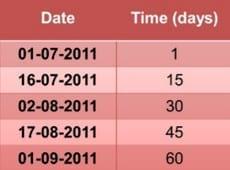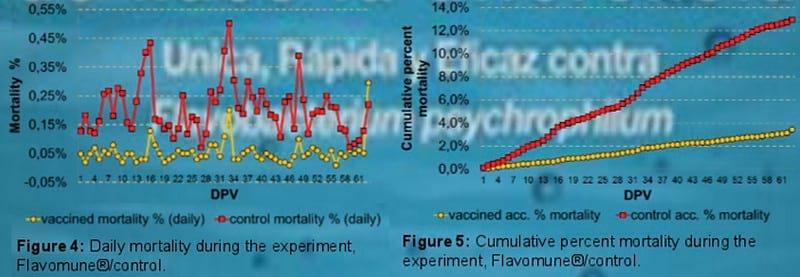Bath vaccination of rainbow trout (Oncorhynchus mykiss Walbaum) against Flavobacterium psychrophilum under field conditions in Chile
Effective bath immunization systems may be very helpful to the salmon industry, particularly during the freshwater growth stages in which vaccination through injection is not possible. Protection of rainbow trout fry (Oncorhynchus mykiss) following bath vaccination with a bacterin, made with two Chilean pathogenic strains of F. psychrophilum, the bacterial pathogen causing Bacterial Cold Water Disease (BCWD), was investigated in productive conditions in a commercial farm in southern Chile. Production parameters such as weight, daily mortality percentage and cumulative mortality in approximately 20,000 rainbow trout of 3.9 g mean initial weight, were investigated. The fishes were divided in 4 groups (two vaccinated groups and two control groups) over a period of 63 days equivalents to 460 degree days (average daily temperature of the farm 7.3± 0.4°C). At the end of the trial a positive 106% growth difference was obtained in the vaccinated group was 3.9 times less mortality in the vaccinated group compared to the control group was record. Moreover, there was a decrease in the number of treatments in the vaccinated group compared to the control group. In addition, serum antibody responses of rainbow trout were determined by enzyme–linked immunosorbent assay (ELISA) after 63 days post vaccination (DVP) with F. psychrophilum vaccine, the titer of the vaccinated group was 8 times higher than the control group. In this study, the bath vaccination against F. psychrophilum in rainbow trout was investigated in productive conditions.


During the trial, 460 UTA were accumulated and the temperature variation is shown in figure 2. It parallels that of from normal conditions typical of this geographical area.

Figure 2: temperature slope July to September, 2011.

Figure 3: growth Flavomune® experience July to September, 2011.

Figure 6: serum antibody responses of rainbow trout after 460 UTA post immunization.
LaFrentz BR., LaPatra SE., Jones GR., Congleton JL., Sun B. & Cain KD. 2002. Characterization of serum and mucosal antibody responses and relative per cent survival in rainbow trout, Oncorhynchus mykiss (Walbaum), following immunization and challenge with Flavobacterium psychrophilum. Journal of Fish Diseases. 25(12):703–713.
Lorenzen E., Brudeseth BE., Wiklund, T. & Lorenzen N. 2010. Immersion exposure of rainbow trout (Oncorhynchus mykiss) fry to wildtype Flavobacterium psychrophilum induces no mortality, but protects against later intraperitoneal challenge. Fish & Shellfish Immunology.28: 440–444.
Madetoja J., Lonnstrom LG., Bjorkblom C., Ulukoy G., Bylund G., Syvertsen C., Gravningen K., Norderhus E–A. & Wiklund T. 2006. Efficacy of injection vaccines against Flavobacterium psychrophilum in rainbow trout Oncorhynchus mykiss (Walbaum). Journal of Fish Diseases. 29(1):9–20.
Nematollahi A., Decostere A., Pasmans F. & Haesebrouck F. (2003). Flavobacterium psychrophilum infections in salmonid fish. Journal of Fish Diseases. 26: 563–574.
Tatner MF. 1985. The effects of vaccine dilution, length of immersion time, and booster vaccinations on the protection levels induced by direct immersion vaccination of brown trout, Salmo trutta, with Yersinia ruckeri (ERM) vaccine. Aquaculture. 46: 11–18.
Torroba M., Anderson DP., Dixon OW., Casares F., Varas A., Alonso L., Gómez del Moral, M. & Zapata AG. 1993. In vitro antigen trapping by gill cells of the rainbow trout: an immunohistochemical study. Histol Histopathol.8: 363–367.
Valdebenito S. & Avendaño–Herrera R. (2009). Phenotypic, serological and genetic characterization of Flavobacterium psychrophilum strains isolated from salmonids in Chile. Journal of Fish Diseases. 32: 321–333.





.jpg&w=3840&q=75)